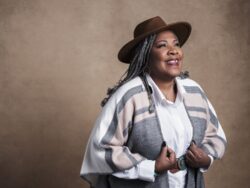
About our guest author: Melody Starya Mobley’s experiences as the first black woman serving as a forester for the USDA are remarkable: both for the firsts she embodies and for the years of abuse and oppression she experienced within that system.
Now, Melody shares her personal stories to create positive change for groups historically excluded from accessing American natural spaces.
With the few federal protections that exist currently being stripped away, it’s more important than ever for stories like these to be told. To read more of Melody’s writing, visit her website.
Image credit: Kirth Bobb
We must talk about it.
As the first African American female forester in the USDA Forest Service, I experienced many, many examples of discrimination, hazing, and assault in my professional environment—too many to include here.
But if we don’t talk about this, it’ll never stop, which is my primary goal in sharing my own stories. In outlining several of the most significant events, I hope to bring some attention to job environment realities in natural resource conservation and management.
I’m passionate about furthering diversity, equity, inclusion, and justice: I want to do everything I can to make sure my profession is welcoming and prosperous for everyone, no matter their race or gender.
Our voices were silenced or ignored.
Let’s start with “being heard.” I often had a seat at the table. I was chosen to attend meetings and conferences purely because I’m a Black woman, and they wanted one in the room. And only one, since I was usually the only woman and only person of color at such events.
But once at the table, my input and comments were routinely ignored. At this point, most of us are familiar with the pattern I’ve experienced: a person of color or a woman makes a comment, everyone nods politely or there’s no acknowledgment at all. A few minutes later, that comment is repeated by a White man to great agreement. If the original speaker says something about having already offered that idea, they’re labeled aggressive. If, for some reason, it’s the White man who has been repeated, he can speak up and is admired as appropriately assertive.
This is clearly discrimination. The person of color or woman is expected to be seen and not heard. Their voice is ignored or silenced.
“Silencing” came in many different forms.
I was silenced in other ways, even as I was routinely subject to extreme hazing and even assault. Sometimes the hazing seemed to be dangerous rituals, and sometimes it seemed more personal.
For instance, when I was first assigned to the Seminole Ranger District in Central Florida, I experienced hazing at its worst. I supervised a timber crew of about eight men, who invited me to a “welcome to the district” reception one evening.
When they asked if I’d like to see some of the alligators at the lake nearby, I excitedly joined them because I love animals and any chance to see wildlife. Thrilled to see the alligators, I was instead thrown off a pier into the lake—I didn’t know how to swim, and suddenly found myself in about eight feet of coal-black water. Now terrified of the water and the alligators, I barely crawled out of the lake onto the pier.
This is only one of many assaults, with no consequences to the employees assaulting me. In 1978, I was sexually assaulted by a colleague on a government compound. Later that year, an engineer coworker ripped my uniform blouse open.
In the mid-nineties, I was at a conference and asked the chief of one of our sister agencies to be considered for any possible job openings. He invited me to his hotel room to drop off a copy of my resume, but he assumed I was actually offering him sex. When he put his hands on my breasts, I hastily apologized for that impression. He knew he was wrong to touch me in any way, but this was the only possible chance I saw to avoid reprisal. When I immediately went back downstairs and told my supervisor what happened, he of course took no action to protect me.
In 2004, a man I supervised kissed his finger and put it on my lips before I could push his hand away—and a woman I supervised in Washington, D.C., hit me in the abdomen with a fully loaded book cart on my first day back from a six-week recovery from abdominal surgery. During the same period, another male colleague knocked me into a partition so hard it fractured a vertebra in my back.
Let’s normalize change, not retaliation.
Even this list is just a small part of the full set of experiences that paint a picture of my daily life in the Forest Service. In each of these cases, none of the witnesses helped me. I had to call the police and file charges, and my supervisor Douglas MacCleery took me to the emergency room.
I filed Equal Employment Opportunity (EEO) complaints time and time again—for these and other incidents. That only served to exacerbate my colleagues’ treatment of me. Then-Deputy-Chief of International Forestry Jeff Sirmon even publicly humiliated me at a reception in the Chief’s Office. Although EEO processes are supposed to be confidential, he shouted that I was costing the agency a lot of money by filing complaints.
Rather than doing anything to stop the discrimination and harassment I experienced, Sirmon and other top agency managers further exacerbated it by focusing their attention on preventing ramifications to the Forest Service. Even as hazing and assaults destroyed my health, they blamed me for the budget threats rather than my coworkers who were causing the complaints.
Allowing this kind of behavior built a work culture that remains unwelcoming to people of color and women even now. Hopefully, sharing my own stories can further calls for change.
![]()
Read more of Melody’s writings
on the American Green blog.
